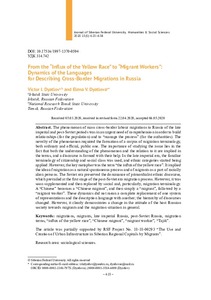From the “Influx of the Yellow Race” to “Migrant Workers”: Dynamics of the Languages for Describing Cross-Border Migrations in Russia
Скачать файл:
URI (для ссылок/цитирований):
https://elib.sfu-kras.ru/handle/2311/135294Автор:
Dyatlov, Victor I.
Dyatlova, Elena V.
Дятлов, В.И.
Дятлова, Е.В.
Дата:
2020-05Журнал:
Журнал Сибирского федерального университета. Гуманитарные науки. Journal of Siberian Federal University. Humanities & Social Sciences;2020 13 (5)Аннотация:
The phenomenon of mass cross-border labour migrations to Russia of the late imperial and post-Soviet periods was in an urgent need of comprehension in order to build relationships (for the population) and to “manage the process” (for the authorities). The novelty of the phenomenon required the formation of a corpus of migration terminology, both ordinary and official, public one. The importance of studying the issue lies in the fact that both the understanding of the phenomenon and the relation to it are implied in the terms, and a discourse is formed with their help. In the late imperial era, the familiar terminology of citizenship and social class was used, and ethnic categories started being applied. However, the key metaphor was the term “the influx of the yellow race”. It implied the idea of migration as a natural spontaneous process and of migrants as a part of racially alien persons. The Soviet era preserved the dominance of primordialist ethnic discourse, which prevailed at the first stage of the post-Soviet era migration process. However, it was soon supplemented and then replaced by social and, particularly, migration terminology. A “Chinese” becomes a “Chinese migrant”, and then simply a “migrant”, followed by a “migrant worker”. These dynamics did not mean a complete replacement of one system of representations and the description language with another; the hierarchy of discourses changed. However, it clearly demonstrates a change in the attitude of the host Russian society towards migrants and the migration situation in general Феномен массовых трансграничных трудовых миграций в Россию
позднеимперского и постсоветского периодов остро нуждался в осмыслении –
с тем, чтобы выстраивать взаимоотношения (для населения) и «управлять
процессом» (для властей). Новизна феномена требовала формирования корпуса
миграционной терминологии – как обыденной, так и официальной, публичной.
Важность изучения проблемы состоит в том, что в термины закладывается как
понимание феномена, так и отношение к нему, с их помощью формируется дискурс.
В позднеимперскую эпоху использовалась привычная терминология подданства
и сословия, начали применяться этнические категории, однако ключевой была
метафора, ставшая термином – «наплыв желтой расы». В нем концентрировалось
представление о миграции как о природном стихийном процессе и о мигрантах
как части расово чуждых природных тел. Советская эпоха оставила господство
примордиалистского этнического дискурса, который преобладал на первой стадии
миграционного процесса постсоветской эпохи. Вскоре он начал дополняться, а затем
и вытесняться социальной, собственно миграционной терминологией. «Китаец»
становится «китайским мигрантом», затем просто «мигрантом», на смену которому
приходит «гастарбайтер». Эта динамика не означала полной замены одной системы
представлений и языка описания другой, меняется иерархия дискурсов. Однако она
отчетливо показывает смену отношения принимающего российского общества к
мигрантам и миграционной ситуации в целом
Коллекции:
Метаданные:
Показать полную информациюСвязанные материалы
Показаны похожие ресурсы по названию, автору или тематике.
-
Youth with a Migrant Background: Are They Willing to Stay in Russia?
Rocheva, Anna L.; Varshaver, Evgeni A.; Ivanova, Nataliya S.; Рочева, А. Л.; Варшавер, Е. А.; Иванова, Н. С. (Сибирский федеральный университет. Siberian Federal University, 2019-07)In the context of current demographic situation in Russia, migration is considered one of the most efficient ways of population maintenance if not upsurge. Labour migrants coming to Russia are mostly young people. Moreover, ... -
Development of Theoretical Provisions on the Adaptation and Integration of Migrants
Kononov, Leonid A.; Ledeneva, Viktoria Yu.; Кононов, Л. А.; Леденева, В. Ю. (Сибирский федеральный университет. Siberian Federal University, 2019)Recently, the terms “adaptation and integration of migrants” are often found in scientific and public literature. However, there is still no unified opinion and clear understanding of the essence and content of these ... -
«Третье место» в повседневности молодых мигрантов дальневосточных городов
Винокурова, А. В.; Ардальянова, А. Ю.; Vinokurova, Anna V.; Ardalyanova, Anna Yu. (Journal of Siberian Federal University. Сибирский федеральный университет, 2024-10)Представленное в данной статье исследование опирается на концепт, предложенный Р. Ольденбургом, согласно которому «третьи места» – это пространства, где люди проводят время между домом («первое место») и работой («второе ... -
Forced Migration in Modern Europe and Russia: Situation, Problems and Possible Ways to Optimize the Refugee Law
Volokh, Vladimir A.; Волох, В.А. (Сибирский федеральный университет. Siberian Federal University, 2016-04)The article by Professor V.A. Volokh is dedicated to one of the most controversial issues of our time – migration issues in and out of Russia. In the context of economic and political globalization not only basic ... -
Socialization of Tajik Students in Tomsk University Space: Looking for Models and Meaning
Pogodaev, Nikolay P.; Погодаев, Н.П. (Сибирский федеральный университет. Siberian Federal University, 2016-04)In the last ten years, the number of students from Tajikistan studying at Tomsk universities has been steadily increasing. Statistics of the Ministry of Education and Science of the Russian Federation shows that this ...

